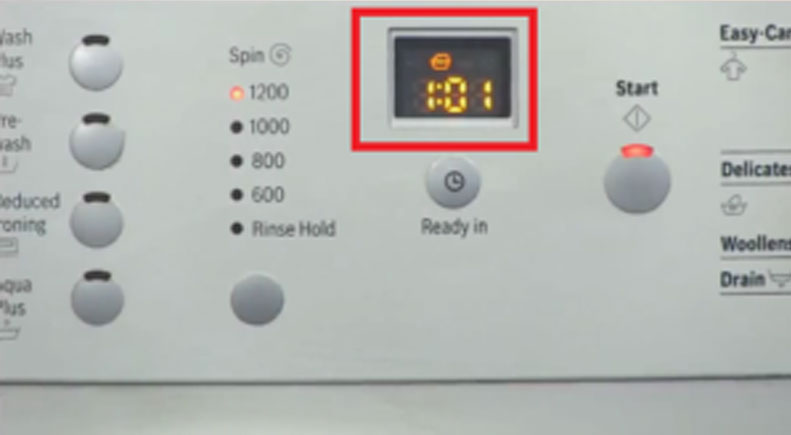
If the timer freezes on the washing machine, then, in most cases, the problem is far from it. However, for some reason, the machine cannot complete the program normally, and the time until the end of the wash stops counting. Let's determine why this happens and where to start diagnosing a home assistant.
If the machine freezes for the first time, it is necessary to exclude the banal glitch of the system. To do this, restart the equipment - turn off the washer using the power button and turn off the power to the device. After 20-30 minutes, plug the cord into the outlet and try to start the cycle. I will reset the system error, and the home assistant will work normally.
When restarting does not help, diagnostics of the washing machine will be required. To check the machine, it is necessary to drain the water from the tank and remove the laundry from the drum. If the washing machine is frozen, pressing the Drain button will not work, and must remove the waste liquid through the garbage filter. The algorithm of actions is as follows:
After draining, you can start diagnosing the washing machine. Modern machines imply a rather complex intelligent control. The system functions due to numerous semiconductor elements, tracks, microcircuits, and sensors, which can fail even with small voltage drops.
So, to provoke freezing of the washing machine can:
What to do first? To quickly identify a breakdown, remember when the washing machine is frozen and the timer stops working. Then, let's see how diagnostics are performed.
The sudden stop of the washing machine complicates the diagnosis because the display does not always have time to display the fault code. Therefore, you must look for what broke, focusing on your logic and guesses. First, remember when the CMA hung - at the beginning, in the middle of the cycle, or closer to the end of the wash. This will indicate possible problems.
If the timer hangs on the automatic machine at the very beginning of the wash, the reason may be a non-working hatch lock sensor or a failed electronic module. There is another option - user error. For example, you exceed the maximum load weight or make an incorrect program selection.
Usually, if it is an overload or an erroneously selected mode, the self-diagnosis system of the washing machine manages to detect a failure. It displays the corresponding fault code on display. If the culprit is the control module, then in most cases, the error is not displayed.
If UBL causes the freeze, the washer can still display an error code on the screen. Checking the locking mechanism is easy - try opening the hatch. If the door quietly succumbed, then the lock was faulty. When the sash does not swing open, everything is in order with safety.
Another reason is a faulty control board. In this case, it will be challenging to perform diagnostics with your own hands - you will need the help of specialists. Inexperience can easily damage microcircuits and semiconductors, so you should wait to start an independent repair. It is better to entrust the flashing of the module to professionals.
When the machine stops working already during the cycle, you can sin on completely different parts. To find a breakdown, you need to analyze the behaviour of the washer immediately before the failure. Remember what stage of the program was performed, whether the equipment was noisy, and whether there were warning signals. Let's analyze the scenarios that are most typical for automata.
To check the details, put the multimeter into resistance measurement mode. Next, the tester probes are applied to the contacts of the element. Must compare the values displayed on the device screen with the normative ones.
Identifying the cause of the machine freezing is half the battle. The next step is to take corrective action. You can fix most breakdowns with your hands. The main thing is to understand the sequence of the repair.
Before troubleshooting, realistically evaluate your strength so as not to harm the equipment. For example, in case of problems with electronics, it is better to entrust diagnostics and repairs to specialists. Another thing is a clogged drain, a faulty solenoid valve, or a blown pump. You can replace these parts independently without involving the master.
To get rid of the blockage, it is enough to clean the trash filter and impeller blades from wound threads or hair, remove dirt from the pump and rinse the drain corrugation under water pressure. Even a beginner will cope with this work.
It will be more difficult to replace the intake valve. So, let's figure out what to do in this case.
If the timer on the automatic machine is frozen, you must first reboot the system. Usually, disconnecting the device from the power supply and restarting it after half an hour helps to solve the problem. However, when it's not a system failure, repairs are needed - the cause of the problem is identified, and measures are taken to eliminate it.
Copyright © 2020 Coimbatore Service.